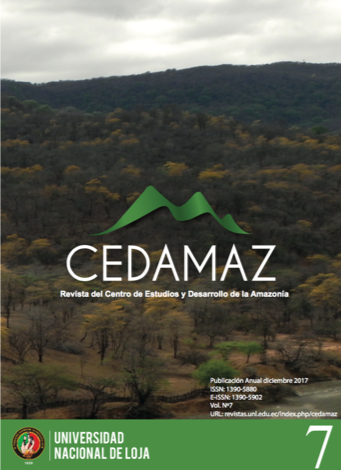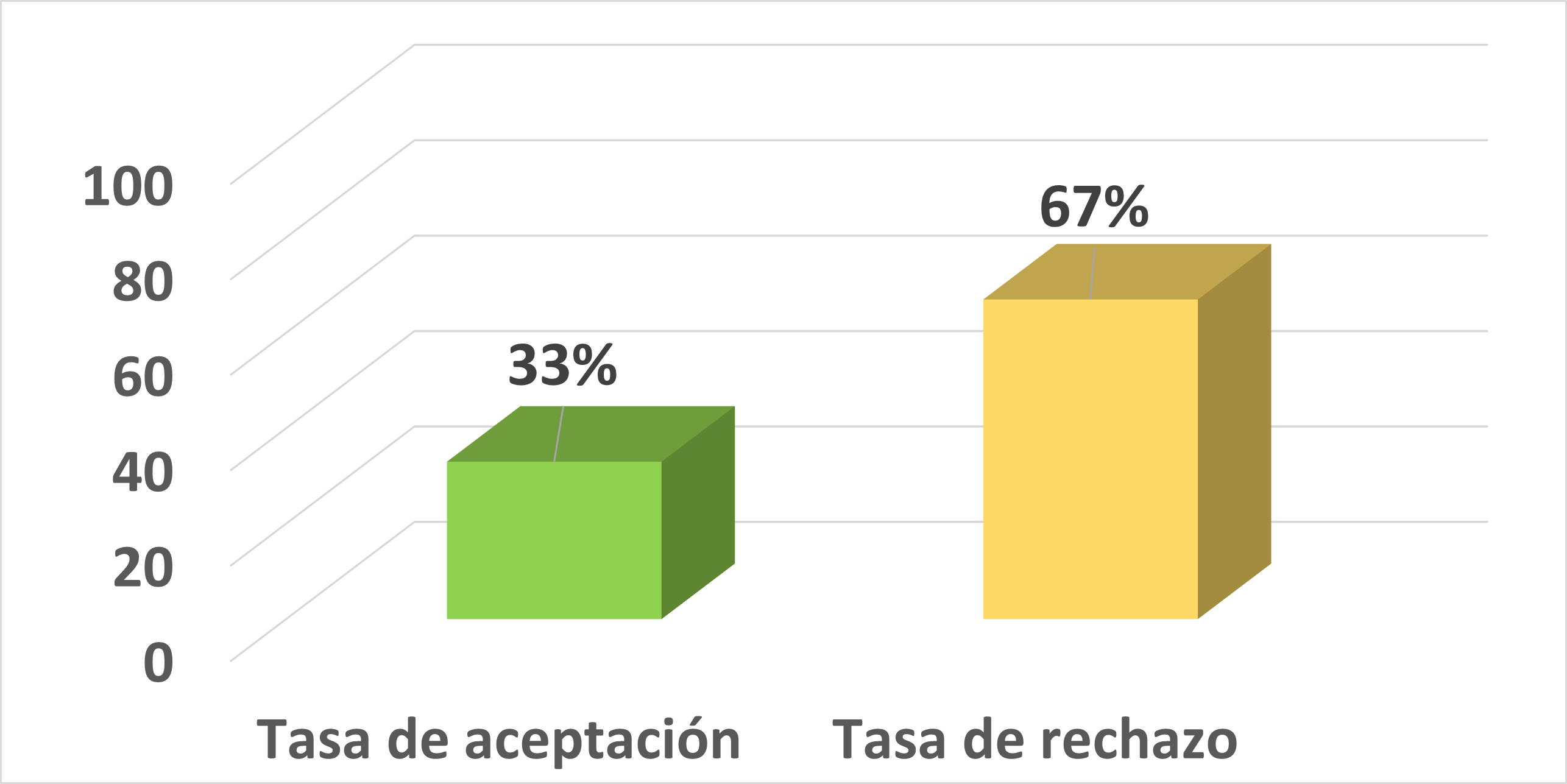Caracterización molecular y filogenética de cepas del virus de la enfermedad de Newcastle, aislado de zonas rurales del sur del Ecuador
Palabras clave:
Análisis filogenético, Proteína de fusión, Proteína hemaglutinina-neuraminidasa, Virus de la enfermedad de Newcastle.Resumen
El virus de la enfermedad de Newcastle es un paramyxovirus aviar altamente contagioso y el principal agente devastador de aves de corral, causando pérdidas económicas en la industria avícola alrededor del mundo. En esta investigación se caracterizaron molecularmente ocho secuencias parciales del gen de la proteína de Fusión y tres secuencias completas del gen de la proteína hemaglutinina-neuraminidasa de aislados del virus presentes en gallinas criollas en la región sur del Ecuador en el año 2014 de aves de traspatio no vacunadas. Dichas secuencias se compararon con otras secuencias de virus de la enfermedad Newcastle, representando diferentes genotipos del virus y subgenotipos desde diferentes regiones del mundo. Todos los virus mostraron la secuencia de aminoácidos 112GRQGR-L117 en el extremo terminal C de la proteína F2 y mostraron Leucina en el extremo terminal N de la proteína F1. Estas secuencias nos permitieron determinar que estos virus pertenecían a un tipo de virus lentogénico. El análisis filogenético de la región parcial del gen F y proteína HN demostró que la mayoría de los virus aislados en esta región del Ecuador estaban estrechamente relacionados con cepas del genotipo II de la clase II, consistente con la secuencia de vacunas de virus vivos lentogénicos, La Sota y B1. La caracterización molecular y el estudio filogenético de los genes de la proteína F y HN podrían usarse confiablemente como una herramienta de vigilancia y detección temprana del virus de la enfermedad de Newcastle, así como predecir los diferentes patotipos de aislados del virus.Citas
Altschul S.F., M.S. Boguski, W. Gish & J.C. Wootton (1994). Issues in searching molecular sequence databases. Nature genetics 6(2): 119-129.
Ayllon J. (2009). El virus de la enfermedad de Newcastle: Modelo de Interacción virus-célula y vector de expresión. Tesis Doctoral. Departamento de Bioquímica y Biología Molecular, Universidad de Salamanca. España. 31 pp.
Briceño C., J. Rodriguez & S. Rodriguez (2012). Seroprevalencia de la enfermedad de Newcastle en gallos de pelea (Gallus gallus) del municipio de Saboya, Boyaca. Conexión Agropecuaria JDC (Revista Electrónica) 2(1): 25-34. Disponible en: http://www.revistasjdc.com/main/index.php/conexagro/article/view/182 [Consultado 14 enero 2015]
Cárdenas S., R. Navarro, R. Morales, M. Olvera, M. Marquez, R. Merino, P. Miller & C. Afonso (2013). Molecular epidemiology of Newcastle disease virus in Mexico and the potential spillover of viruses from poultry into wild bird species. Applied and Environmental Microbiology 79(16): 4985-4992.
Collins M.S., J.B. Bashiruddin & D.J. Alexander (1993). Deduced amino acid sequences at the fusion protein cleavage site of Newcastle disease viruses showing variation in antigenicity and pathogenicity. Archives of virology 128(3-4): 363-370.
Cuello S., A. Vega & J. Noda (2011). Actualización sobre la enfermedad de Newcastle. Revista electrónica de Veterinaria (REDVET) 12(6): 1-30. Disponible en: http://www.veterinaria.org/revistas/redvet/n12061/061111.pdf [Consultado 27 junio 2014].
Diel D., L. Susta, S. Cardenas, M. Killian, C. Brown, P. Miller & C. Afonso (2011). Complete Genoma and clinicopathological characterization of a virulent Newcastle Disease virus isolate from south america. Journal of Clinical Microbiology 50(2): 378-387.
Farooq M., U. Saliha, M. Munir & Q. Khan (2014). Biological and genotypic characterization of the Newcastle disease virus isolated from disease outbreaks in comercial poultry farms in northern Punjab, Pakistan. Virology Reports 3: 30-39.
Fernandes C., A. Varani, E. Lemos, V.O. de Miranda, K. Silva, F. Fernando, M. Montassier & E. Montassier (2014). Molecular and phylogenetic characterization based on the complete genoma of a virulent pathotype of Newcastle disease virus isolated in the 1970s in Brazil. Infection, Genetics and evolution 26: 160-167.
Ferrer M., D. Icochea & S. Salas (2008). Prevalencia de anticuerpos contra el virus de la enfermedad de Newcastle en Gallus gallus de Lima: Estudio de caso-control. Revista de Investigaciones Veterinarias del Perú 19(1): 67-74.
Gould A.R., J.A. Kattenbelt, P. Selleck, E. Hansson, A. Della-Porta & H.A. Westbury (2001). Virulent Newcastle disease in Australia: molecular epidemiological analysis of viruses isolated prior to and during the outbreaks of 1998–2000. Virus research 77(1): 51-60.
Gravel K.A., L.W. McGinnes, J. Reitter & T.G. Morrison (2011). The transmembrane domain sequence affects the structure and function of the Newcastle disease virus fusion protein. Journal of virology 85(7): 3486-3497.
Hall T.A. (1999). BioEdit: a user-friendly biological sequence alignment editor and analysis program for Windows 95/98/NT. Pp. 95-98. En: Nucleic acids symposium series 41.
Heiden S., C. Grund, A. Roder, H. Granzow, D. Kuhnel, T. Mettenleiter & A. Romer-Oberdorfer (2014). Different regions of the Newcastle disease virus fusión protein modulate pathogenicity. PLoS ONE 9(12): 1-19.
Hosseini H., A.G. Langeroudi & R. Torabi (2014). Molecular characterization and phylogenetic study of Newcastle disease virus isolated in Iran 2010-2012. Avian Diseases 58(1): 373-376.
Jindal N., Y. Chander, A. Chockalingam, M. Abin, P. Redig & S. Goyal (2009). Phylogenetic analysis of Newcastle disease viruses isolated from waterfowl in the upper midwest región of the United States. Virology Journal 6(1): 191-199.
León R., O. Vargas, M. Guevara & M. Solano (2009). Análisis Molecular de una cepa de virus de Newcastle de origen vacunal aislada a partir de un hisopado cloacal de aves sanas en Costa Rica. Revista electrónica de Veterinaria (REDVET) 10(11): 1-19. Disponible en: http://www.veterinaria.org/revistas/redvet/n111109/111105.pdf [Consultado 27 junio 2014].
Mazumder A., S. Khatun, M. Nooruzzaman, E. Chowdhury, P. Das & M. Islam (2012). Isolation and identification of Newcastle Disease Virus from field outbreaks in chickens and pigeons. The Bangladesh Veterinarian 29(2): 41-48.
Marín M.C., P. Villegas, J.D. Bennett & B.S. Seal (1996). Virus characterization and sequence of the fusion protein gene cleavage site of recent Newcastle disease virus field isolates from the southeastern United States and Puerto Rico. Avian diseases 40(2): 382-390.
Miller P., M. Kim, H. Ip & C. Afonso (2009). Evolutionary dynamics of Newcastle disease virus. Virology 391: 64-72.
Moreno V., A. Garcia & C. Mathieu (2009). Caracterización Molecular y patogenicidad del virus de la enfermedad de Newcastle (ENC) aislado en cormoranes. Boletín veterinario Oficial (BVO) 9. Disponible en: http://www2.sag.gob.cl/Pecuaria/bvo/BVO_9_I_semestre_2009/aritculos/caracterizacion_ENC_2007_pdf [Consultado 27 junio 2014].
Munir M., M. Abbas, M. Tanveer Khan, S. Zohari & M. Berg (2012). Genomic and biological characterization of a velogenic Newcastle disease virus isolated from a healthy backyard poultry flock in 2010. Virology Journal 9(1): 46-56.
Qin Z., L. Tan, H.Y. Xu, B.C. Ma, Y.L. Wang, X.Y. Yuan & W.J. Liu (2008). Pathotypical characterization and molecular epidemiology of Newcastle disease virus isolates from different hosts in China from 1996 to 2005. Journal of Clinical Microbiology 46(2): 601–611.
Qiu X., Y. Yu, S. Yu, Y. Zhan, N. Wei, C. Song & C. Ding (2014). Development of Strand-Specific Real-Time RT-PCR to Distinguish Viral RNAs during Newcastle Disease Virus Infection. The Scientific World Journal, 934851.
Rabalski L., K. Smietanka, Z. Minta & B. Szewczyk (2014). Detection of Newcastle Disease Virus minor genetic variants by modified single-stranded conformational polymorphism analysis. BioMed Research International, 632347.
Ronquist F. & J.P. Huelsenbeck (2003). MrBayes 3: Bayesian phylogenetic inference under mixed models. Bioinformatics 19: 1572-1574.
Sanger F., S. Nicklen & A.R. Coulson (1977). DNA sequencing with chain-terminating inhibitors, Proceedings of the National Academy of Sciences 74: 5463–5467.
Seal, B. S. (2004). Nucleotide and predicted amino acid sequence analysis of the fusion protein and hemagglutinin-neuraminidase protein genes among Newcastle disease virus isolates. Phylogenetic relationships among the Paramyxovirinae based on attachment glycoprotein sequences. Functional & integrative genomics 4(4): 246-257.
Seal B., D. King & J. Bennett (1995). Characterization of Newcastle Disease Virus isolates by reverse transcription PCR coupled to direct nucleotide sequencing and development of sequence database for pathotype prediction and molecular epidemiological analysis. Journal of Clinical Microbiology 33(10): 2624-2630.
Shengqing Y., N. Kishida, H. Ito, H. Kida, K. Otsuki, Y. Kawaoka & T. Ito (2002). Generation of Velogenic Newcastle Disease Viruses from a Nonpathogenic Waterfowl Isolate by Passaging in Chickens. Virology 301: 206-211.
Tamura, K., G. Stecher, D. Peterson, A. Filipski & S. Kumar (2013). MEGA6: molecular evolutionary genetics analysis version 6.0. Molecular biology and evolution 30(12): 2725-2729.
Tan L-T., H-Y. Xu, Y-L. Wang, Z-M. Qin, L. Sun, W-J. Liu & Z-Z. Cui (2008). Molecular characterization of three new virulent Newcastle disease virus variants isolated in China. Journal of Clinical Microbiology 46(2): 750-753.
Tirumurugaan K., S. Kapgate, M. Vinupriya, K. Vijayarani, K. Kumanan & S. Elankumaran (2011). Genotypic and pathotypic characterization of Newcastle Disease Viruses from India. Plos One 6(12): 1-10.
Toyoda T., B. Gotoh, T. Sakaguchi, H. Kida & Y. Nagai (1988). Identification of amino acids relevant to three antigenic determinants on the fusion protein of Newcastle disease virus that are involved in fusion inhibition and neutralization. Journal of Virology 62: 4227–4430.
Umali D.V., H. Ito, K. Shirota, H. Katoh & T. Ito (2014). Characterization of complete genome sequence of genotype VI and VII velogenic Newcastle Disease Virus from Japan. Virus genes 49(1): 89-99.
Umali D., H. Ito, T. Suzuki, K. Shirota, H. Katoh, T. Ito & Toshihiro (2013). Molecular epidemiology of Newcastle Disease Virus isolates from vaccinated comercial poultry farms in non-epidemic áreas of Japan. Virology Journal 10(330): 1-17.
Uthrakumar A., K. Vijayarani, K. Kumanan & V. Thiagarajan (2013). Molecular characterization of termostable Newcastle Disease Virus isolated from pigeon. Indian Journal Virology 24(1): 42-47.
Villacís G., G. Escudero, F. Cueva & A. Luzuriaga (2014). Aislamiento del virus de la enfermedad de Newcastle en zonas rurales del Sur del Ecuador. CEDAMAZ 4(1): 86-90.
Wang J., H. Liu, W. Liu, D. Zheng, Y. Zhao, Y. Li & Z. Wang (2015). Genomic Characterizations of Six Pigeon Paramyxovirus Type 1 Viruses Isolated from Live Bird Markets in China during 2011 to 2013. PloS One 10(4): e0124261.
Yusoff K. & W.S. Tan (2001). Newcastle disease virus: macromolecules and opportunities. Avian Pathology 30(5): 439-455.
Descargas
Publicado
Cómo citar
Número
Sección
Licencia
Aquellos autores/as que tengan publicaciones con esta revista, aceptan los términos siguientes:
-
Luego que el artículo científico es aceptado, para su publicación el o la autora aceptan ceder los derechos de la primera publicación a la Revista CEDAMAZ, conservando sus derechos de autor. Se permite la reproducción total o parcial de los textos que se publican siempre y cuando sea sin fines de lucro. Cuando se ejecute la reproducción total o parcial de los artículos científicos aceptados y publicados en la revista CEDAMAZ, se debe citar la fuente completa y la dirección electrónica de la publicación.
-
Los artículos científicos aceptados y publicados en la revista CEDAMAZ pueden ser depositados por los autores de manera integra en cualquier repositorio sin fines comerciales.
-
Los autores no deben distribuir los artículos científicos aceptados, pero que todavía no han sido publicados oficialmente por la revista CEDAMAZ. En el caso de incumplir esta norma implica el rechazo del articulo científico.
- La publicación de su obra, el cuál estará simultáneamente sujeto a la Licencia de reconocimiento de Creative Commons









